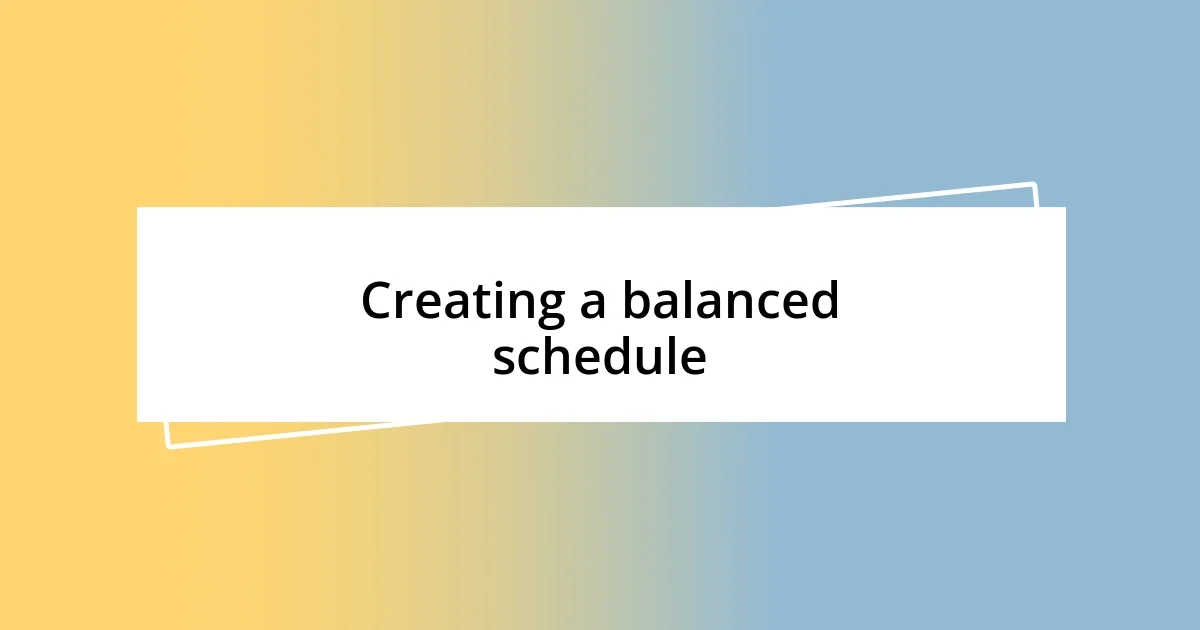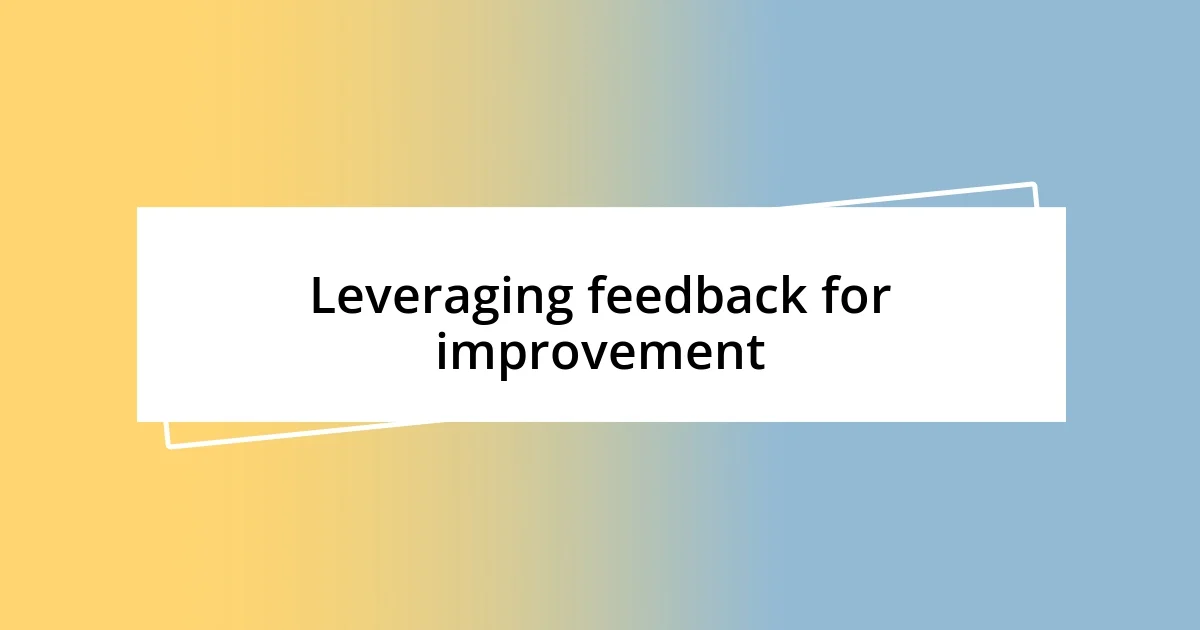Key takeaways:
- Balancing writing and editing requires recognizing the distinct mindset for each role, with writing focused on creativity and editing emphasizing clarity.
- Setting realistic and flexible writing goals, along with creating a structured schedule, helps manage the writing and editing process effectively.
- Leveraging feedback from others and reflecting on personal progress is crucial for growth as both a writer and an editor.

Understanding the dual roles
Balancing the roles of editing and writing can feel like juggling—each task demands focus and creativity. I remember vividly when I first embraced both roles; it was exhilarating but also overwhelming. I often questioned myself: “How do I wear both hats effectively without losing my voice?”
While writing, I pour my heart into each word, letting ideas flow freely. Yet, when I switch to editing, I must adopt a more critical mindset, dissecting my own work to enhance clarity and impact. I still vividly recall the moment I edited a piece I was initially proud of, only to realize it was muddled in its message. That stark contrast between creation and refinement taught me to appreciate the necessity of each role.
Sometimes, I feel a tension between my writer’s flair and my editor’s precision. It can be a struggle; I often have to remind myself that neither role diminishes the other. By recognizing the distinct energy each role requires, I’ve learned to alternate between embracing creativity and honing my craft, finding a rhythm that allows both my passion and professionalism to shine.

Identifying your editing style
Identifying your editing style is a crucial part of finding balance in your writing process. I’ve found that my editing approach mirrors my personality—meticulous but also intuitive. For instance, during one editing session, I went from a detailed line-by-line review to stepping back and assessing the piece’s overall flow. This shift allowed me to reconnect with the emotional core of my writing, enriching the edits I made afterward.
Here are some characteristics to consider as you identify your editing style:
- Detail-oriented vs. Big-picture: Do you thrive on perfecting every sentence, or do you prefer to focus on overall structure and flow?
- Intuitive vs. Analytical: Are your edits guided by gut feelings, or do you rely heavily on logical analysis?
- Collaborative vs. Independent: Do you seek feedback while editing, or do you prefer to work solo?
- Time-consuming vs. Efficient: How much time do you typically spend on edits? Do you savor the process or aim for quick turnarounds?
Understanding how these facets play into your editing style can empower you to cultivate a balanced approach.

Setting realistic writing goals
Setting realistic writing goals is vital for anyone who wants to find equilibrium between writing and editing. In my journey, I’ve learned that setting achievable benchmarks keeps me motivated and on track. For example, instead of aiming to write an entire chapter in one go, I focus on completing a single page or even a paragraph. This approach eliminates the overwhelming pressure and allows me to enjoy the writing process more fully.
I also find it helpful to break down larger projects into manageable tasks. When I was working on a short story, I dedicated specific days solely to character development or plot outlines. This separation not only made the writing less daunting but also fostered a sense of accomplishment with each little victory. I still celebrate those milestones, as they remind me that progress, no matter how small, is still progress.
Understanding that my goals need to be flexible is another crucial aspect. Sometimes, despite planning, life gets in the way. I’ve learned to adjust my expectations when unforeseen circumstances arise, allowing grace for myself. This adaptability has helped me maintain a more sustainable and enjoyable writing practice.
| Writing Goal | Realistic Approach |
|---|---|
| Complete a chapter | Write a paragraph or page |
| Finish a project in one week | Break it into daily manageable tasks |
| Strict timeline | Flexible deadlines based on progress |

Creating a balanced schedule
Creating a balanced schedule is all about understanding your natural rhythms. I’ve always noticed that my creativity tends to peak in the mornings, so I allocate those hours for writing when my mind is fresh. It’s a game changer! How often have you found yourself trying to write late at night, battling fatigue? I decided that switching things up and embracing my peak hours invigorated my productivity and enhanced my writing quality.
To keep my momentum going, I schedule dedicated blocks for editing later in the day. This separation lets me view my work from a fresh perspective. One afternoon while revising a piece, I couldn’t help but be surprised at how much an evening break improved my critical eye. The simple act of stepping away made all the difference. Do you ever feel overwhelmed when juggling both tasks? By scheduling specific times, I’ve carved out a rhythm that feels almost like a dance, allowing me to move effortlessly between writing and editing.
Lastly, I’ve learned to be protective of my time. Filling out a weekly planner has been a revelation for me—it keeps my writing goals in sight and reduces the overwhelming clutter of tasks. I color-code my writing days versus editing days, which visually reminds me of my priorities. What tools or systems do you use to keep yourself organized? For me, this visual aspect not only engages my creativity but also ensures I’m mindful of balancing both sides of my writing process.

Techniques for efficient editing
When it comes to efficient editing, I’ve found that taking breaks is one of the best techniques. After hours of writing, diving straight into editing can feel overwhelming and lead to burnout. I learned this the hard way after spending an entire day on a piece, only to feel frustrated by the edits that seemed impossible. Now, I intentionally step back—sometimes I take a walk or do some light reading. These breaks reset my mind, and when I return to the text, I can see it with fresh eyes.
Another strategy I swear by is reading my work aloud. Initially, I was skeptical about this approach, thinking it wouldn’t be effective. But I gave it a shot one day, and it truly transformed my editing process. Hearing the words helped me catch awkward phrases and identify places where the flow just felt off. Have you ever noticed how much differently words sound when spoken? This technique not only sharpens the editing but also deepens my connection to the narrative.
Lastly, I can’t emphasize the power of utilizing feedback enough. I actively seek out fellow writers for constructive criticism. Once, after sharing a draft with a writing group, I received insights I hadn’t considered. Their perspectives challenged me and opened new avenues for improvement. It was a reminder that collaboration is not just beneficial but essential. How do you embrace feedback in your writing journey? For me, it has been a vital part of evolving as an editor and writer alike.

Leveraging feedback for improvement
Utilizing feedback has transformed the way I approach both writing and editing. I remember the first time I shared my work with a trusted friend; I was a bundle of nerves. But when I received constructive feedback, it felt like an awakening! Their insights highlighted areas I hadn’t even considered, leading me to refine my narrative and deepen my characters. Have you ever experienced a moment where feedback turned your views upside down? It’s a game changer!
Another aspect I cherish is the emotional connection that comes from engaging with others’ thoughts. Recently, I joined an online community where writers share their drafts. I was surprised by how much value I derived from others’ perspectives. It’s incredible how different viewpoints can spark new ideas and enhance creativity. I often find myself pondering questions like, “What if I approached this scene differently?” and that curiosity drives me to explore new possibilities.
Even when the feedback feels tough to digest, I’ve learned to embrace it. I recall a time when a critique cut deep, but instead of shutting down, I took a step back and examined the points made. That initial sting morphed into gratitude as I realized how these critiques were paving the way for my growth. How often do we let our pride take over? For me, overcoming that hurdle allowed me to grow not just as a writer but as an editor, too. Embracing feedback isn’t just about improving a piece—it’s about evolving into a more capable storyteller.

Measuring success and adjusting strategies
Success in writing and editing isn’t always about achieving a set goal; it’s often about the little victories along the way. For instance, I keep a record of the drafts I’ve completed and the feedback I’ve received. Reflecting on my progress, I find that revisiting earlier drafts reminds me of how much I’ve grown. Have you ever looked back at your work from a few months ago and realized how much you’ve learned since? Those moments can be incredibly motivating and serve as a benchmark for my future endeavors.
Adjusting strategies is vital when I notice that something isn’t working. I recall a time when I was struggling with a particular piece. Despite putting in the hours, I wasn’t happy with the outcome. Instead of sticking with the same approach, I decided to switch gears completely. I tried free writing to explore fresh angles and unique ideas that hadn’t crossed my mind before. This pivot turned out to be not just productive but enlightening. How often do you find that a change in strategy can flip the script on what you’re trying to achieve?
I’ve also learned to set measurable goals for my writing sessions. For example, I might aim to edit ten pages or write five hundred words. This helps me track my productivity and adjust if I’m falling short. If I find myself only making it through two pages, I take a step back and ask why. Was I distracted, or perhaps the material needs more thought? It’s about tuning into my creative rhythm and understanding my unique workflow. Giving yourself permission to adjust can transform not just your writing journey, but how you measure success as a whole.














